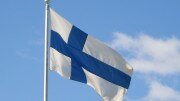Air traffic in passenger numbers through Avinor’s airports increased by 4.1 per cent in 2017. Traffic through Oslo airport increased by 6.6 per cent. The increase is related to an improving Norwegian economy and the fact that Norway is perceived as a safe country to both invest in and visit.
This is apparent from Avinor’s Annual and Corporate Social Responsibility report for 2017, which will be published today.The report also documents that there were no accidents in Norwegian aviation in 2017 where Avinor was a party. And despite frequent difficult weather conditions and major development projects in Oslo and Bergen, punctuality and regularity were high. Punctuality was 85 per cent, and regularity was 98 per cent.
– In general, there is considerable understanding of the importance of aviation in Norwegian society, as well as concern about its impact on the environment and climate. Efforts relating to effective climate and environmental measures must be reinforced. Avinor’s goal is to be a leader in the aviation sector with regard to climate and the environment, emphasizes Dag Falk-Petersen, Avinor’s CEO, in the foreword to the report.
Biofuels and electrification
Avinor has taken several key initiatives to introduce jet biofuel in aviation. In January 2016 Oslo airport became the first major airport in the world to offer jet biofuel to all airlines. In 2017 this was also introduced at Bergen airport, Flesland. There are plans to extend the service to more airports in the time ahead.
According to Avinor, electrification is the second road towards sustainable aviation. In recent years, there have been rapid and promising developments in this area. In the course of only a few years the first electrically powered passenger aircraft will be tested and put into production – and the manufacturers of electric aircraft view the Norwegian local network as a particularly interesting market.
– Our aim is that all domestic aviation in Norway shall be electric by 2040! At that point, aviation will no longer be a contributor to climate problems; it will be a contributor to solutions to climatic challenges, says Dag Falk-Petersen.
Sound financial position
The Group’s operating income in 2017 was NOK 11,526 million (NOK 10,788 million in 2016), and the profit after tax was NOK 499 million (NOK 1029 million in 2016).
Low sick leave rate
There were 3,098 permanent employees in the Avinor group at the end of 2017.Sick leave in 2017 was 4.5 per cent, which corresponds to Avinor’s goal as an inclusive working life company. The Group has worked actively to reduce breaches of the working time regulations in the Working Environment Act, which resulted in a total reduction in the number of breaches by 27 per cent compared with 2016. The LTI rate, which is a measure of the number of work accidents with absence per million worked hours, was 1.4 in 2017 compared to 4 in 2016. The percentage of women among Avinor’s permanent employees is 22 per cent. The Group aims to increase its percentage of women employees to 25 per cent in 2020, and this is being monitored closely.




